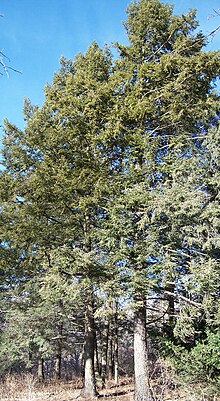| Tsuga canadensis | |
|---|---|

| |
| Large specimens at Morton Arboretum | |
| Scientific classification | |
| Kingdom: | Plantae |
| Clade: | Tracheophytes |
| Clade: | Gymnospermae |
| Division: | Pinophyta |
| Class: | Pinopsida |
| Order: | Pinales |
| Family: | Pinaceae |
| Genus: | Tsuga |
| Species: | T. canadensis
|
| Binomial name | |
| Tsuga canadensis | |

| |
| Natural range | |

| |
| Closeup view of range | |

Tsuga canadensis, also known as eastern hemlock,[3] eastern hemlock-spruce,[4] or Canadian hemlock, and in the French-speaking regions of Canada as pruche du Canada, is a coniferous tree native to eastern North America. It is the state tree of Pennsylvania.[5] Eastern hemlocks are widespread throughout much of the Great Lakes region, the Appalachian Mountains, the Northeastern United States, and Maritime Canada. They have been introduced in the United Kingdom and mainland Europe, where they are used as ornamental trees.
Eastern hemlock populations in North America are threatened in much of their range by the spread of the invasive Hemlock woolly adelgid, which infests and eventually kills trees. Declines in population from hemlock wooly adelgid infestation have led to Tsuga canadensis being listed as Near Threatened on the IUCN Red List.
Eastern hemlocks are long lived trees, with many examples living for more than 500 years. They can grow to heights of more than 30 metres (100 ft), and are tolerant of shade, moist soil, and slopes. Hemlock wood is used in construction, and for railroad ties. Historically its bark was an important source of tannin for the leather tanning industry.[6] Eastern hemlocks are popular as ornamental trees, thanks to their tolerance of a wide variety of soil and light conditions, as well as their characteristic drooping branches.
- ^ Farjon, A. (2013). "Tsuga canadensis". IUCN Red List of Threatened Species. 2013: e.T42431A2979676. doi:10.2305/IUCN.UK.2013-1.RLTS.T42431A2979676.en. Retrieved 11 November 2021.
- ^ "NatureServe Explorer 2.0". explorer.natureserve.org. Retrieved 12 April 2022.
- ^ NRCS. "Tsuga canadensis". PLANTS Database. United States Department of Agriculture (USDA). Retrieved 12 December 2015.
- ^ BSBI List 2007 (xls). Botanical Society of Britain and Ireland. Archived from the original (xls) on 2015-06-26. Retrieved 2014-10-17.
- ^ Cite error: The named reference
Taylorwas invoked but never defined (see the help page). - ^ Godman, R. M. "Eastern Hemlock". www.srs.fs.usda.gov. Retrieved 2021-12-13.

